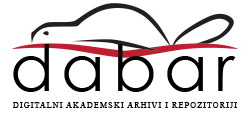Title Galileijeva teorija gibanja Title (english) The Galileau Theory of Motion Author Martina Bošnjaković Mentor Tihomir Vukelja (mentor)Committee member Tihomir Vukelja (predsjednik povjerenstva)Committee member Mirko Planinić (član povjerenstva)Committee member Gorjana Jerbić-Zorc (član povjerenstva)Committee member Vito Despoja (član povjerenstva)Committee member Maja Planinić (član povjerenstva)Granter University of Zagreb Defense date and country 2016-02-24, Croatia Scientific / art field, NATURAL SCIENCES Abstract Teorija gibanja koju je razvio Galileo Galilei bila je odlučujući korak prema modernoj – Newtonovoj – teoriji gibanja. Pri tome je bilo važno Galileijevo shvaćanje gibanja kao stanja tijela, a ne kao kod Aristotela, kao razvoja ili procesa ozbiljenja forme, njegovo naglašavanje relativnosti gibanja, razmatranje inercijalnog gibanja, a napose matematički prikaz slobodnog pada i putanje projektila, koji je pristašama „mehaničke filozofije“ u 17. stoljeću poslužio kao oslonac razmatranja mogućnosti matematičkoga opisivanja svih „zemaljskih“ gibanja. U radu se prikazuje Galileov kratki životopis kao uvod u kontekst tadašnjeg vremena koji je bitna komponenta razumijevanja cjelokupne situacije. Razmatra se Aristotelova teorija, kao ona prihvaćena na sveučilištima Galileijeva doba, te posljedice koje je ona imala po tadašnja kozmološka razmatranja. Potom je, kao središte rada, opisana Galileijeva motivacija za teorijsko i eksperimentalno istraživanje gibanja i rezultati koji su proizašli iz tog istraživanja. Veličina njegove teorije leži u odvajanju uzroka gibanja od samog opisa gibanja, te u zamjeni potrage za uzrocima i počelima svijeta, modernom potragom za fizičkim zakonima koji ga opisuju. Primjenivši apstraktni matematički model na realnu situaciju, eksperimentalno je ustanovio kako se realno gibanje tijela zaista može matematički opisati i time postavio temelje jedinstvu praktičnog iskustva s apstraktnom znanošću te otvorio vrata eksperimentalnoj znanosti i daljnjem razvoju fizike. Galileo je efektivno promijenio način na koji su ljudi razumijevali gibanje i uveo radikalno drugačiji način povezivanja gibanja i geometrije. Nadalje, prikazane su rane reakcije znanstvene zajednice na Galileijevu teoriju gibanja, te učinak te teorije na razvoj fizike. Konačno, spomenuta je, samo usput, kontroverzna tema odnosa vjere i znanosti. Rad sadrži i pripremu za nastavnu jedinicu horizontalni hitac koja se prema gimnazijskom i četverogodišnjem strukovnom nastavnom planu i programu nalazi u obveznom, a prema dvogodišnjem i trogodišnjem planu i programu nastave fizike u proširenom sadržaju.
Abstract (english) The theory of motion developed by Galileo Galilei was a crucial step towards the modern, Newton's theory of motion. The important thing was Galileo's understanding of the motion as a state of body, as opposed to Aristotle's development or process of the actualisation of the form; Galileo's stress on the relativity of motion, the analysis of inertial motion, above all the mathematical description of the free fall and projectile trajectory served as a stepping stone for the analysis of the possibility of mathematical descriptions of all „terrestrial“ motions to the supporters of the „mechanical philosophy“ in the 17th century. Galileo's short curriculum vitae is presented in the thesis as an introduction to the context of those times, which is an important part for understanding the situation as a whole. Aristotle's theory, as the one accepted at the universities of Galilei time, together with its consequences upon cosmological research has been explored. The central part of the thesis describes Galilei's motivation for theoretical and empirical research of motion together with the results. The greatness of his theory lies in separating the cause of motion from the very description of the motion itself, and replacing the search for causes and principles of the world with a modern search of physical laws that describe it. By applying the abstract mathematical model to a real-life situation, Galileo experimentally proved that the actual body motion can really be mathematically described. Therewith he set the grounds for unity of practical experience and abstract science and opened the doors to experimental science and further development of physics. Galileo effectively changed the way people understood motion and introduced a different way of connecting motion and geometry. Also, the early reactions of the scientific community to Galilei motion theory are presented as well as the effect of this theory to the deveopment of physics. Finally, the controvertial topic of the relationship between religion and science is mentioned. The thesis contains a lesson plan presenting projectile motion, which is an obligatory part of four-year high school curriculum and a non-obligatory part of two and three-year high school curriculum.
Keywords
Galileo Galilei
Aristotel
teorija gibanja
Keywords (english)
Galileo Galilei
Aristotel
motion theory
Language croatian URN:NBN urn:nbn:hr:217:002989 Study programme Title: Physics and Computer Science; specializations in: Education Type of resource Text File origin Born digital Access conditions Open access Terms of use Repository Repository of the Faculty of Science Created on 2017-03-03 21:33:02

